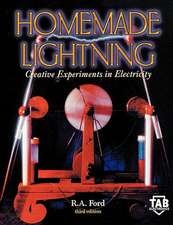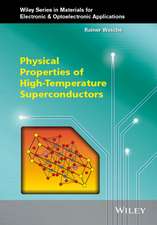Low-Temperature Physics: an introduction for scientists and engineers: An introduction for scientists and engineers
Editat de P. V. E. McClintock, D.J. Meredith, J. K. Wigmoreen Limba Engleză Paperback – 8 noi 2012
Preț: 696.68 lei
Preț vechi: 819.62 lei
-15% Nou
Puncte Express: 1045
Preț estimativ în valută:
133.31€ • 145.26$ • 112.33£
133.31€ • 145.26$ • 112.33£
Carte tipărită la comandă
Livrare economică 23 aprilie-07 mai
Preluare comenzi: 021 569.72.76
Specificații
ISBN-13: 9789401050104
ISBN-10: 9401050104
Pagini: 308
Ilustrații: VIII, 296 p.
Dimensiuni: 152 x 229 x 16 mm
Greutate: 0.41 kg
Ediția:Softcover reprint of the original 1st ed. 1992
Editura: SPRINGER NETHERLANDS
Colecția Springer
Locul publicării:Dordrecht, Netherlands
ISBN-10: 9401050104
Pagini: 308
Ilustrații: VIII, 296 p.
Dimensiuni: 152 x 229 x 16 mm
Greutate: 0.41 kg
Ediția:Softcover reprint of the original 1st ed. 1992
Editura: SPRINGER NETHERLANDS
Colecția Springer
Locul publicării:Dordrecht, Netherlands
Public țintă
ResearchCuprins
1. Introduction.- 1.1 The significance of low temperatures.- 1.2 The Third Law of Thermodynamics.- 1.3 Liquefaction of gases.- 1.4 Solids at low temperatures.- 1.5 Liquid helium.- 1.6 Macroscopic quantization.- 2. Phonons.- 2.1 The model of a solid at low temperatures.- 2.2 Phonon modes and propagation.- 2.3 Thermal properties.- 2.4 Lattice anharmonicity.- 2.5 Scattering of photons.- 2.6 Solid helium—a quantum solid.- 2.7 Phonons and disorder.- 3. Electrons.- 3.1 Electrons in solids.- 3.2 Studies of Fermi surfaces.- 3.3 Transport properties of metals.- 3.4 Scattering of electrons in metals.- 3.5 Semiconductors and localization.- 3.6 Low-dimensional electron systems.- 4. Superconductivity.- 4.1 The transition to the superconducting state.- 4.2 Thermal properties.- 4.3 Electric, magnetic and electrodynamic properties.- 4.4 Theory of superconductivity.- 4.5 Consequences of the BCS theory.- 4.6 Josephson effects.- 4.7 Type II superconductivity.- 4.8 Superconductivity in non-standard systems.- 4.9 High-temperature superconductors.- 5. Liquid helium-4.- 5.1 Influence of Bose-Einstein statistics.- 5.2 Two-fluid properties.- 5.3 Wave propagation.- 5.4 Superfluidity and excitations.- 5.5 Quantized vortices in HeII.- 5.6 The HeII surface and creeping superfluid films.- 5.7 Critical velocities.- 5.8 Other boson fluids.- 6. Liquid helium-3 and3He-4He solutions.- 6.1 Influence of Fermi-Dirac statistics.- 6.2 Properties of normal liquid 3He.- 6.3 The Landau theory of liquid 3He.- 6.4 Superfluid phases of 3He.- 6.5 Liquid 3He-4He solutions.- 6.6 Other fermion fluids.- 7. Experimental methods at low temperatures.- 7.1 Principles of cryostat design.- 7.2 Cooling with 4He.- 7.3 Cooling with 3He.- 7.4 Magnetic cooling.- 7.5 Thermometry and instrumentation.- 8. Applications.- 8.1 Uses oflow temperatures.- 8.2 High-current and magnetic-field applications of superconductivity.- 8.3 Low-temperature electronics.- 8.4 Uses of liquefied gases.
Recenzii
Will serve its intended readership well. - Nature






